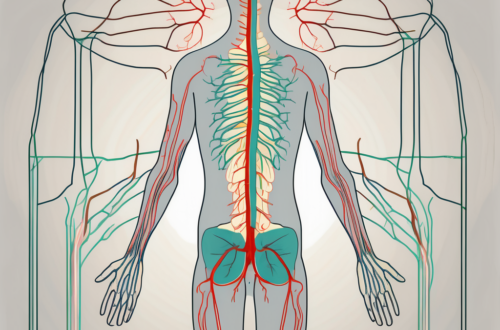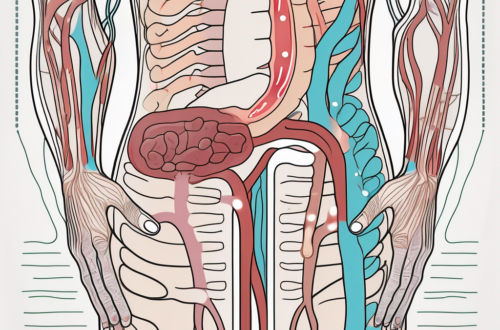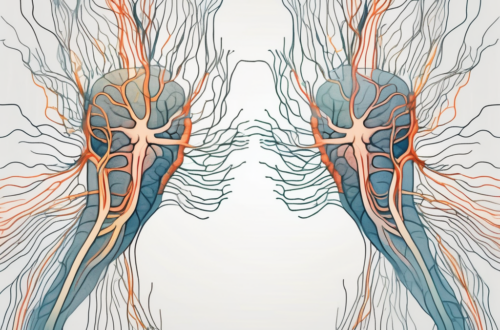The functioning of our body is a complex and intricate process, regulated by various systems working in harmony. One such system that plays a significant role in maintaining our overall health is the nervous system. Within the comprehensive framework of the nervous system, the parasympathetic nerve receptors hold a vital position. In this article, we will delve into the depths of these receptors, exploring their definition, function, and their involvement in regulating different bodily processes.
Overview of the Nervous System
Before delving into the specifics of parasympathetic nerve receptors, it is essential to understand the broader context of the nervous system. The nervous system consists of two primary divisions: the central nervous system (CNS) and the peripheral nervous system (PNS).
The central nervous system comprises the brain and the spinal cord, acting as the command center of the body. It interprets sensory information, initiates responses, and coordinates the overall functioning of the body. The brain, with its billions of neurons, is responsible for complex cognitive processes such as thinking, memory, and decision-making. The spinal cord, a long, cylindrical bundle of nerves, serves as a communication pathway between the brain and the rest of the body. It relays signals to and from the brain, allowing for voluntary and involuntary movements.
On the other hand, the peripheral nervous system consists of nerves that extend throughout the body, connecting the CNS to the organs, muscles, and glands. These nerves transmit information to and from the central nervous system, enabling sensory perception and motor responses. The peripheral nervous system can be further divided into the somatic nervous system and the autonomic nervous system.
The Central and Peripheral Nervous Systems
The somatic nervous system controls voluntary movements and sensory perception. It allows us to consciously interact with our environment, such as walking, talking, or feeling a gentle touch. Sensory neurons carry information from our senses, such as touch, taste, smell, sight, and hearing, to the central nervous system. Motor neurons, on the other hand, transmit signals from the central nervous system to our muscles, enabling us to move and perform actions.
The autonomic nervous system, within the peripheral nervous system, assumes control of involuntary bodily functions. It regulates processes that occur automatically, without conscious effort, such as heart rate, digestion, and breathing. The autonomic nervous system itself is further divided into two complementary branches: the parasympathetic and sympathetic nervous systems.
The Autonomic Nervous System
The sympathetic nervous system is responsible for the body’s “fight or flight” response, preparing us for action in times of stress or danger. It increases heart rate, dilates blood vessels, and releases stress hormones, allowing us to respond quickly and effectively to potential threats. This response is crucial for survival, as it enables us to escape from dangerous situations or confront them head-on.
On the other hand, the parasympathetic nervous system promotes the body’s “rest and digest” response, conserving energy and promoting relaxation. It counterbalances the effects of the sympathetic nervous system, slowing heart rate, constricting blood vessels, and stimulating digestion. The parasympathetic nervous system helps maintain homeostasis, ensuring that our body functions properly during periods of rest and recovery.
Within the parasympathetic nervous system, various receptors play a crucial role in transmitting signals and coordinating bodily functions. These receptors, located on the surface of cells, receive chemical signals called neurotransmitters, which allow communication between neurons. Different types of parasympathetic nerve receptors are responsible for specific physiological responses, such as slowing heart rate, stimulating digestion, and promoting relaxation.
Understanding the intricacies of the parasympathetic nervous system and its associated receptors is essential for comprehending the complex interplay between the different branches of the autonomic nervous system. By studying these receptors, scientists and medical professionals can gain insights into various physiological processes and develop targeted treatments for conditions related to autonomic dysfunction.
Introduction to Parasympathetic Nerve Receptors
Parasympathetic nerve receptors are integral components of the parasympathetic nervous system, working hand in hand to regulate various bodily functions. Understanding their definition, function, and structure is essential to grasp the significance they hold within our overall well-being.
The parasympathetic nervous system, often referred to as the “rest and digest” system, plays a crucial role in maintaining balance in the body. It counteracts the effects of the sympathetic nervous system, which is responsible for the “fight or flight” response. The parasympathetic nerve receptors are key players in this intricate system, ensuring that our bodily functions run smoothly.
Definition and Function
Parasympathetic nerve receptors can be defined as specialized protein molecules located on the surface of target cells within different organs and tissues. These receptors are activated by specific neurotransmitters released by parasympathetic nerve fibers.
When activated, these receptors initiate a cascade of events that ultimately lead to the relaxation and restoration of various bodily functions. They work in harmony with the parasympathetic nervous system to slow down heart rate, increase digestive activity, and promote overall relaxation.
For example, in the digestive system, parasympathetic nerve receptors facilitate the release of digestive enzymes and increase blood flow to the gastrointestinal tract, enhancing the process of digestion and absorption of nutrients.
Location and Structure
The parasympathetic nerve receptors are found in numerous organs and tissues throughout the body. Some notable locations include the heart, smooth muscles within the digestive system, respiratory system, as well as glands such as salivary glands.
In the heart, these receptors are primarily located in the sinoatrial (SA) node, which is often referred to as the “natural pacemaker” of the heart. Activation of the parasympathetic nerve receptors in the SA node leads to a decrease in heart rate, allowing the heart to beat at a more relaxed pace.
Structurally, these receptors can vary depending on their location but generally consist of transmembrane proteins with specific binding sites for neurotransmitters. The activation of these receptors triggers biochemical cascades within cells, leading to appropriate responses in various bodily functions.
For instance, in the respiratory system, parasympathetic nerve receptors are present in the smooth muscles lining the bronchioles. Activation of these receptors causes the muscles to relax, leading to bronchodilation and increased airflow, facilitating efficient gas exchange in the lungs.
Overall, the location and structure of parasympathetic nerve receptors are intricately designed to ensure precise regulation of bodily functions. Their presence in various organs and tissues allows for targeted responses and coordinated actions to maintain homeostasis.
Role of Parasympathetic Nerve Receptors in Body Regulation
With a basic understanding of parasympathetic nerve receptors, we can now explore their fascinating and intricate role in regulating crucial bodily functions.
Regulation of Heart Rate
One of the primary roles of parasympathetic nerve receptors is in the regulation of heart rate. Upon activation, these receptors release neurotransmitters that slow down the heart rate, helping to maintain a steady rhythm and prevent complications related to cardiovascular health.
Furthermore, the parasympathetic nerve receptors work in harmony with the sympathetic nervous system to ensure a delicate balance in heart rate regulation. While the sympathetic nervous system stimulates the heart to beat faster during times of stress or physical exertion, the parasympathetic nervous system, through its receptors, counteracts this effect by slowing down the heart rate during periods of rest and relaxation.
Digestive System Control
The parasympathetic nerve receptors also play a prominent role in the regulation of the digestive system. Activation of these receptors stimulates increased secretion of enzymes and digestive juices, facilitating the breakdown and absorption of nutrients. Moreover, they also contribute to the contraction of smooth muscles in the digestive tract, aiding in the smooth movement of food through the system.
Interestingly, the parasympathetic nerve receptors are responsible for triggering the release of saliva in the mouth, which is the first step in the digestive process. This initial secretion of saliva, rich in enzymes, helps to break down carbohydrates and initiate the process of digestion even before food reaches the stomach.
Respiratory System Regulation
The respiratory system is another area where parasympathetic nerve receptors display their significance. Activation of these receptors leads to bronchoconstriction, which narrows the airways, allowing for more control over respiration and ensuring proper oxygen exchange within the lungs.
In addition to bronchoconstriction, the parasympathetic nerve receptors also regulate the secretion of mucus in the respiratory system. This mucus serves as a protective layer, trapping foreign particles and preventing them from entering the lungs. By controlling mucus production, the parasympathetic nerve receptors contribute to maintaining the health and integrity of the respiratory system.
Moreover, these receptors are involved in the regulation of breathing patterns. By modulating the activity of the diaphragm and other respiratory muscles, they help to ensure the smooth and coordinated movement of the chest wall during inhalation and exhalation.
The Interplay between Parasympathetic and Sympathetic Nervous Systems
It is crucial to note that the parasympathetic nervous system does not act in isolation. Instead, it works alongside the sympathetic nervous system to maintain a delicate balance within the body.
The parasympathetic and sympathetic nervous systems are two branches of the autonomic nervous system, which controls involuntary bodily functions. While the sympathetic nervous system prepares the body for action, the parasympathetic nervous system promotes relaxation and restoration. Their interplay ensures that our bodies can respond appropriately to both internal and external stimuli.
Balancing Act of the Nervous Systems
The sympathetic nervous system is often referred to as the “fight-or-flight” response, responsible for preparing the body for high-stress situations. When faced with a threat, whether real or perceived, the sympathetic nervous system kicks into gear. It triggers a series of physiological responses that help us either confront the danger or flee from it.
During the fight-or-flight response, the sympathetic nervous system releases stress hormones like adrenaline and cortisol. These hormones increase heart rate, blood pressure, and blood flow to the muscles, preparing the body for action. At the same time, the sympathetic nervous system dilates the airways, allowing for increased oxygen intake, and mobilizes energy reserves to provide a burst of energy.
While the sympathetic nervous system is essential for survival in threatening situations, prolonged activation can have detrimental effects on the body. Chronic stress can lead to increased blood pressure, weakened immune system, and even mental health issues.
In contrast, the parasympathetic nervous system acts as a counterbalance to the sympathetic nervous system. It is responsible for the body’s rest and digest response, promoting relaxation and restoration. When the threat or stressor subsides, the parasympathetic nervous system takes over, helping the body return to a state of calm.
The parasympathetic nervous system slows down heart rate, constricts the airways, and promotes digestion and nutrient absorption. It conserves energy and allows the body to focus on repair, growth, and recovery.
Impact on Body’s Response to Stress
During stressful situations, the sympathetic nervous system dominates, preparing the body for immediate action. This response is crucial for survival, as it allows us to react quickly in dangerous situations. However, it is equally important for the parasympathetic nervous system to kick in once the threat has passed.
When the parasympathetic nervous system is activated, it counteracts the effects of the sympathetic nervous system. It helps lower heart rate, blood pressure, and stress hormone levels, allowing the body to return to a state of equilibrium.
Rest and recovery are essential for maintaining overall health and well-being. The interplay between the parasympathetic and sympathetic nervous systems ensures that our bodies can effectively respond to stress while also promoting relaxation and restoration.
It is worth noting that the balance between these two systems can vary from person to person. Some individuals may have a more dominant sympathetic response, while others may have a more active parasympathetic response. Factors such as genetics, environment, and lifestyle can influence this balance.
In conclusion, the interplay between the parasympathetic and sympathetic nervous systems is crucial for maintaining a delicate balance within the body. While the sympathetic nervous system prepares us for action, the parasympathetic nervous system promotes relaxation and restoration. Together, they ensure that our bodies can respond appropriately to stress and maintain overall well-being.
Disorders Associated with Parasympathetic Nerve Receptors
Despite the significant role parasympathetic nerve receptors play in maintaining our well-being, like any other system, they can also be susceptible to disorders. Understanding these disorders, their symptoms, and the available treatment options is crucial for those experiencing such conditions.
Parasympathetic nerve receptors are an essential component of the autonomic nervous system, which regulates involuntary bodily functions. These receptors are responsible for promoting rest and relaxation, controlling heart rate, digestion, and respiratory functions. However, when these receptors malfunction or become impaired, various disorders can arise.
One common disorder associated with parasympathetic nerve receptors is cardiovascular conditions. These disorders can manifest as irregular heart rhythms, also known as arrhythmias. Arrhythmias can cause the heart to beat too fast, too slow, or irregularly, leading to symptoms such as palpitations, dizziness, and shortness of breath. In severe cases, arrhythmias can even result in cardiac arrest, requiring immediate medical attention.
Digestive disorders are another group of conditions linked to parasympathetic nerve receptor dysfunction. These disorders can disrupt the normal functioning of the digestive system, leading to symptoms such as excessive or insufficient secretion of digestive juices. Excessive secretion can cause conditions like gastroesophageal reflux disease (GERD), where stomach acid flows back into the esophagus, causing heartburn and discomfort. On the other hand, insufficient secretion can result in conditions like gastroparesis, where the stomach takes longer to empty its contents, leading to bloating, nausea, and vomiting.
Respiratory ailments are also commonly associated with parasympathetic nerve receptor disorders. These disorders can affect the normal functioning of the respiratory system, leading to difficulties in breathing. One such condition is asthma, where the airways become inflamed and narrow, causing wheezing, coughing, and shortness of breath. Another respiratory disorder is chronic obstructive pulmonary disease (COPD), characterized by progressive airflow limitation and symptoms such as coughing, mucus production, and difficulty in exhaling.
Common Disorders and Symptoms
Some common disorders associated with parasympathetic nerve receptors include cardiovascular conditions, digestive disorders, and respiratory ailments. Symptoms may include irregular heart rhythms, digestive disturbances such as excessive or insufficient secretion of digestive juices, and respiratory difficulties.
It is important to note that these disorders can vary in severity and presentation. Some individuals may experience mild symptoms that are easily manageable, while others may face more severe and debilitating manifestations. Therefore, seeking medical attention and receiving an accurate diagnosis is crucial for appropriate management.
Treatment and Management Options
If you experience any symptoms related to parasympathetic nerve receptor disorders, it is essential to consult with a healthcare professional. They can provide an accurate diagnosis and recommend suitable treatment options. Management may involve lifestyle changes, medication, or other interventions aimed at addressing the specific disorder and promoting overall well-being.
In the case of cardiovascular conditions, treatment options may include medications to regulate heart rate and rhythm, lifestyle modifications such as adopting a heart-healthy diet and regular exercise, and in some cases, surgical interventions like pacemaker implantation or cardiac ablation.
For digestive disorders, treatment approaches may involve dietary modifications, such as avoiding trigger foods and eating smaller, more frequent meals. Medications can also be prescribed to reduce acid production or improve gastric motility. In severe cases, surgical interventions may be necessary to correct structural abnormalities or remove obstructions.
Respiratory ailments associated with parasympathetic nerve receptor disorders can be managed through various means. Medications such as bronchodilators and corticosteroids are commonly prescribed to alleviate symptoms and reduce airway inflammation. Pulmonary rehabilitation programs, which include exercise training and education, can also help improve lung function and overall respiratory health.
Furthermore, lifestyle modifications such as smoking cessation and avoiding environmental triggers like allergens or pollutants are essential in managing respiratory disorders. In severe cases, advanced interventions like oxygen therapy or lung transplantation may be considered.
In conclusion, disorders associated with parasympathetic nerve receptors can significantly impact an individual’s well-being. Understanding the symptoms and available treatment options is crucial for effective management. By seeking medical attention and adopting appropriate interventions, individuals can strive to maintain a balanced autonomic nervous system and improve their overall quality of life.
Future Research Directions in Parasympathetic Nerve Receptors
As our understanding of the nervous system expands, so does the potential for future research regarding parasympathetic nerve receptors. Unlocking their full potential and exploring new therapeutic applications holds promise for the future of healthcare.
Potential Therapeutic Applications
Researchers are investigating various potential therapeutic applications for parasympathetic nerve receptors. These include targeted drug therapies aimed at modulating receptor activity, potential interventions to improve heart rate regulation and respiratory function, and strategies to alleviate symptoms associated with digestive disorders.
Unanswered Questions and Challenges
However, as we move forward, countless questions and challenges await. Researchers continue to seek answers regarding the complex interplay between parasympathetic and sympathetic nervous systems, as well as the exact mechanisms of receptor activation and regulation.
In conclusion, understanding the role of parasympathetic nerve receptors within our body is essential for comprehending the intricate workings of the nervous system. These receptors play a significant role in regulating heart rate, digestion, and respiratory functions. By working together with the sympathetic nervous system, they ensure that our bodies function harmoniously in response to internal and external stimuli. If you suspect any disorders related to these receptors, it is vital to seek medical advice for a comprehensive evaluation and appropriate treatment. As researchers continue to explore this fascinating field, the potential for future therapeutic applications and further insights into these receptors holds immense promise for enhancing our well-being.





